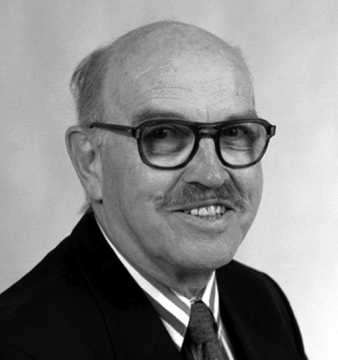RememberingMerlonLynnStevenson

Remembering Merlon Lynn Stevenson
1923 – 2021
Merlon L. “Lynn” Stevenson, a broadly gifted experimental physicist, teacher, and administrator whose research touched many paths connecting Berkeley Lab’s origin to its future, died peacefully at home on April 10, 2021, at age 97.
As one of two founding members of Luis Alvarez’s research group at UC’s Radiation Lab, Stevenson’s career spanned much of Berkeley Lab’s particle-physics history. At his first international conference presentation (in a 1953 session chaired by Fermi), he described the production of what are now understood to be quark-antiquark bound states (mesons) by protons from Lawrence’s 184-inch cyclotron.
Shortly afterward, the bubble chamber invented by Don Glaser was further developed by the Alvarez group for use at Berkeley’s Bevatron. There the discovery of many two- and three-quark states, for which Alvarez won the 1968 Nobel Prize, spawned the quark model that survives today. In an era when data consisted of bubble-chamber tracks on film scanned by humans, traced on millimeter paper, and
reconstructed using mechanical calculators, Stevenson contributed ideas and methods for analyzing those data, discovering the two-quark state most similar to a photon. Over the subsequent four decades he initiated and contributed to many of Berkeley Lab’s particle-physics projects.
As a dedicated teacher, Stevenson delighted in stimulating the scientific interests of all with whom he made contact, especially including Berkeley’s youngest students. Among his doctoral advisees were George Kalbfleisch (Brookhaven/Oklahoma), John Marriner (Fermilab), and J.W. “Bill” Gary (UC Riverside), whose scientific careers have been especially productive. As an administrator, Stevenson served as Physics Department Vice Chair in 1963.
Stevenson was born on Oct. 31, 1923 in Ogden, Utah. His post-secondary education was interrupted after one year by service in WW II as a U.S. Army combat engineer, where he received considerable training and experience. In 1946 he earned a B.A. in physics from UC Berkeley, to which he returned in 1948 for graduate study leading to a 1953 physics Ph.D. (supervised by Panofsky and Alvarez). After joining the Berkeley faculty in 1957, Stevenson became a full professor in 1964 and retired in 1991. Among other honors, he was a Senior NSF fellow (Heidelberg, 1966-67) and an APS fellow (1985-). From 1948 until her death in 2009, he was married to the former Lois Griffin; they leave 5 children and 15 grandchildren.
After the Bevatron’s bubble-chamber era, Stevenson recognized the unique advantages of that technique for studying neutrino interactions, becoming an early advocate for the 15-foot bubble chamber in Fermilab’s neutrino beam. With collaborators including Peterson (Hawaii) and Marriner, Stevenson added a major new capability to that device by building its External Muon Identifier. Using the EMI, their 1975-77 experiment showed evidence for strange-particle production by neutrinos, implying that charmed particles (which so far had been seen only indirectly) must exist in the quark model.
Following the 1974 discovery of bound charm-anticharm at SLAC’s SPEAR electron-positron collider and elsewhere, Stevenson was one of the earliest proponents of the much larger PEP electron-positron collider at SLAC. Berkeley Lab’s participation (led by William Chinowsky, Gerson Goldhaber, and George Trilling) in that SPEAR discovery (led by Burton Richter), as well as its work on the PEP proposal, enhanced Berkeley’s prospects for building a major new detector for PEP. That opportunity was seized by an international group formed by David Nygren, exploiting his invention of the Time Projection Chamber. That group, of which Stevenson was a charter member, succeeded in constructing the resulting experiment (PEP-4), which collected data nearly until his retirement. Based on those data was Bill Gary’s pioneering work on the role of color flow in quark fragmentation. Thereafter the TPC concept spread to many generations of detectors in diverse subfields.
In the mid-1980’s Stevenson joined the Berkeley Lab group led by Ron Madaras that worked on construction of the liquid-argon electromagnetic endcap calorimeter for the DZero experiment at Fermilab’s proton-antiproton collider. Designing that novel detector, constructed using large plates of depleted uranium, posed unique challenges that attracted Stevenson’s interest. In a series of delightful reports, he studied topics ranging from subtle electrical and mechanical design issues to performance for physics measurements. That detector played a key role in DZero’s 1995 discovery (in parallel with CDF’s) of the top quark.
An account of Stevenson’s research could not be accurate without highlighting the thread that connected all his accomplishments. He approached everything he undertook with tremendous enthusiasm, broadly communicated with unusual warmth and sensitivity. Throughout his life, Stevenson inspired both his contemporaries and his younger colleagues with his sheer love of doing physics.
Written by Mark Strovink with assistance from Angela Galtieri, and Anthony Spadafora